Stepping on to Staple Island for the first time is an experience like no other. It’s a busy place and everywhere you look there are birds, on the ground, in the sky and on the water surrounding you. And that’s not to mention the hundreds of photographers camera’s clicking away simultaneously at all these subjects, providing a chorus of natural and man made noises that creates a real assault on the senses. And the star of this show, without a shadow of a doubt, are the puffins!
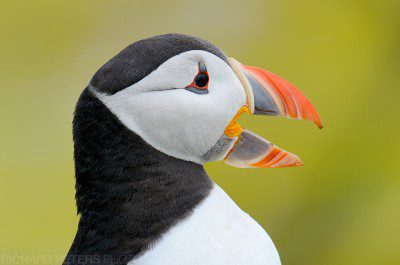
Nikon D7000, 600 VR, 1/400, f7.1, ISO 160
It’s a funny thing, having been to various places outside of the UK in order to point my camera at species not found nearer home, I’ve not been to some of the classic home grown locations, so when a little plan was proposed with fellow wildlife photographers Austin Thomas and Alan Hewitt to visit the Farnes, I couldn’t say no! And so, we set about organising a two day shoot on the islands to coincide with the middle of the puffin season. We even dubbed the trip ‘ProjectPuffin’ for a bit of fun, building up a nice little following on Twitter as we tweeted from the islands during the trip. Even though it was only two days, it was quite an experience, and so I’ve written about it at length here, but tried to give a little info and help on what to expect along the way.
WHAT ARE THE FARNE ISLANDS?
For those that haven’t been before, the Farne Islands are just off the Northumberland coast and are home to thousands of breeding and nesting seabird colonies every year, with the main attraction being the 50,000+ puffins that reside there. The site is run by the National Trust and visitors are able to take boat trips out to two of the main islands, Staple, and Inner Farne, during the months of April to September. The peak breeding season is May to July, which is why we opted to go in June, as it’s right in the middle. This quick video was shot on day two, just after the rain you’ll read about further on, and demonstrates the view when you first get to Staple Island.
Staple is only open in the mornings and Inner during the afternoon. Both of which provide ample photo ops and experiences, with the latter even offering the risk of attack from the local residents, but more on that later. The boat ride across from Seahouses harbour to Staple provides you with a taster of what is to come, with puffins, guillemots, grey seals and more viewable from the boat, both in the sea and on the islands and cliff tops as you approach. The journey across takes roughly 45 minutes or so to get to Staple, and then another 20 minutes from there to get to Inner.
For more info, check out the National Trusts website.
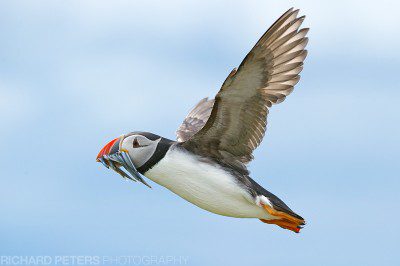
D3s, 200-400, 340mm, 1/3200, f7.1, ISO 2000
A word of warning though, if you are on an all day trip, don’t forget to take food and water with you, because the islands offer no form of amenities, in fact Staple island doesn’t even have a toilet (Inner does, but you won’t be getting there until the afternoon). When it comes to what clothing to wear, I’ve covered that in a little more detail further down but needless to say, you better be prepared to pack for hot, cold, dry and wet weather!
EIDERS IN THE HARBOUR, WILDLIFE FROM THE BOAT
The drive up to Seahouses from West London is 332 miles and, with some clear roads and one pit stop I made the journey in 5 1/2 hours, where I was greeted by Austin as I parked up in the harbour. The light was very dull but we decided to scout the area out as we had heard about the great opportunity to photograph Eider ducks there, and we certainly were not disappointed coming across several females with plenty of chicks in tow! A superb start to the trip.
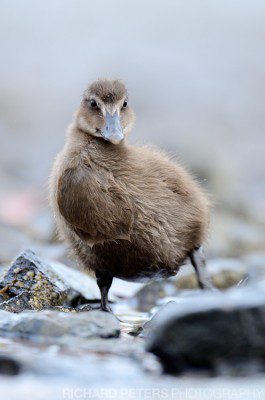
Eider chick, D7000, 600VR, 1/320, f4.5 ISO720
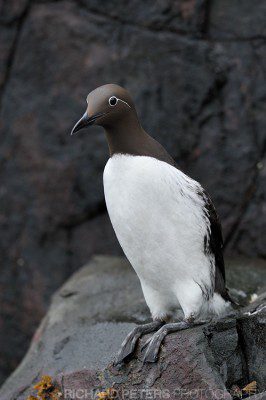
600 VR, 1/2000 and ISO 1250 helped from the boat
As the light was pretty dull that evening, we made our way back to the B&B to freshen up before heading out for food. And here comes my first warning! We found out the hard way that almost everywhere in Seahouses stops serving food after 9pm and the place was almost like a ghost town in the evening. Don’t say I didn’t warn you…!
Alan met us the following morning and both that and the proceeding day would start the same. After a hearty breakfast we set about packing up our gear and heading to the docks. Both Alan and myself suffer from seasickness and so Alan was dosed up on tablets, whereas I had some odd pressure point wrist bands (no, I didn’t think they’d work either and whats worse, they made me look like some eighties sweatband wearing reject!). Thankfully the wind wasn’t too strong and the boat rides across on the ‘Serenity’ were pretty smooth, but that said I did very little talking and apparently looked a very funny shade of grey at one point on the first crossing!
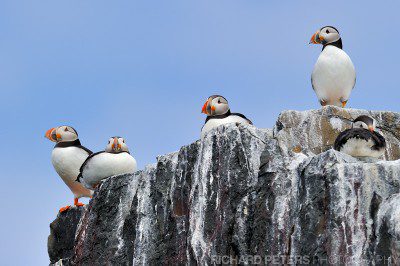
The puffins watch from the cliffs as you sail in
Out of the six boat journeys we had, the later ones were far better and even allowed me to get a couple of handheld shots using my 600 VR. I have to stress though, that I upped the shutter speed to help, but being able to grab a couple of shots from the water was great! So a top tip is to make sure you have your camera at the ready as you cross over, because even if you don’t get many photo ops from birds in the water, you’ll certainly get a few on the cliff faces as you approach.
STAPLE ISLAND
If you haven’t been before then prepare yourself because wow, what a first impression as you leave the boat and walk up the steps. I’m not sure what hit me first, the amount of birds, the noise from them or the sheer amount of people crammed in to a pretty narrow pathway, most of which had 300, 500 and 600mm lenses swinging about all over the place. However, once you walk up past the National Trust wardens (either paying for a ticket or gaining free admission if you’re a member) the crowds begin to thin out ‘slightly’ and it’s easier to find yourself a space to set up. It’s then that you really start to appreciate just how many birds and puffins are all around you and at first, you quite literally don’t know where to point the lens. It was so easy to get swept up in the frenzy of action, that I initially found myself just aiming at anything that moved and firing off shots like some crazed madman that was being timed for a ‘most record shots’ in 5 minutes competition. But I soon came to my senses and realised the best plan of attack is to not just shoot at anything and actually think about what you are doing and trying to achieve. And so after giving myself that little logical reminder I stopped shooting randomly and instead carefully picked my targets out.
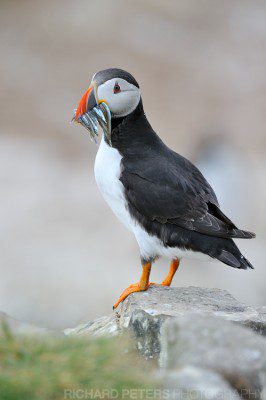
Classic puffin pose, Nikon D3s
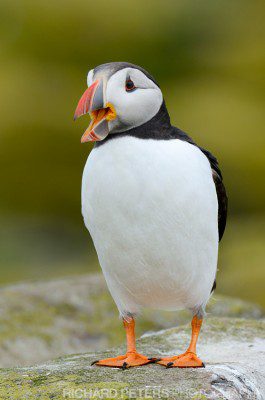
D7000, 600 VR + 1.4x
The main path takes you up over the top of the island, and to your left and right are the puffin burrows. Everywhere you look you’ll see the puffins either standing near their burrows, walking around in the grass or flying through the air at high speed as they go to and from the sea collecting sand eels for their young. Move on further along the path, down the steps and out to the rocks and you can find guillemots, shags and many more inthe thousands. But be warned, if it rains those rocks become very very slippery, and extreme caution needs to be taken.
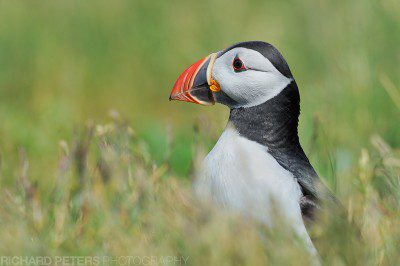
A classic puffin in long grass
Staple is only open in the morning and closes for visitors at 1:30pm but we were lucky enough to be collected last from the island by Andrew, and as such the three of us had the place to ourselves (excluding the very friendly wardens) for around 20 minutes, which was fantastic to really take in the sights and sounds, unobstructed by the mass crowds when we had first arrived.
INNER FARNE, BEWARE THE ARCTIC TERNS
After spending the mornings on Staple we would get picked up by a different boat, the ‘Serenity II’, and head across to Inner Farne, and it’s there the real fun begins. There’s a hint of whats to come when you’re told before you get off the boat to make sure you have a hat or a hood on. And the reason being this island is full of thousands of nesting Arctic Terns. And when a nesting Tern feels threatened it takes to the sky and either tries to peck your head or aim a nice fresh blob of the white stuff in your direction…!
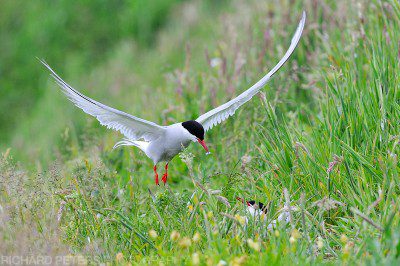
Adult bringing stickleback fish back to the nest
The trouble is, that given there are so many birds, it’s impossible to avoid going near the nests as they are right along the pathways and so you spend half your time walking around the island ducking or feeling the light peck if a Terns beak on your head (I say light, but they have been known to draw blood!). A quick tip is to hold your tripod or mono-pod up, extended above your head as this seems to stop the birds getting as close to you.
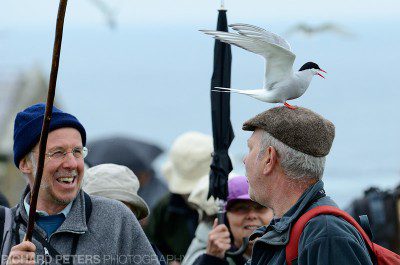
Beware the Arctic Terns on Inner Farne
But regardless, the sound of them flying right up close to your head, screeching so close to your ear is in some ways a wonderful experience, as it’s completely different to anything else you would normally encounter. As a wildlife photographer you always try to avoid disturbing nesting birds, and so it’s almost a surreal experience feeling like your are disturbing thousands all at once on the island. There is refuge from the constant Tern attacks though if you head to the cliffs on Inner Farne as there, it’s business as usual with the puffins in their burrows and the potential for flight shots as they come in off the sea with beaks full of sand eels. As I mentioned above, Inner also has toilet facilities which are a welcome luxury if you’re out all day – but be warned, you run the gauntlet of even more Tern attacks getting to them!
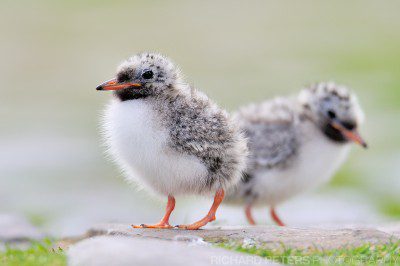
Arctic Tern chicks, D3s, 600 VR, 1/500, f6.3, ISO 360
Because we were the absolute last visitors off the island, it allowed us a little time with clear pathways. And with no human traffic, some of the Terns chicks came out in to the open and because of those clear pathways we were also able to now get down on the ground for clear low level views of them.
WEATHER AND CLOTHING
We were pretty lucky with the weather on our two day trip with both days providing the calm seas required to land on the islands themselves (if it’s too rough, you can’t land on the them) and a mixture of lighting conditions. The one thing I was worried about was the fear of bright sunshine the whole trip. The reason being, summer sun is very bright and harsh, and with puffins being black and white, the combination is less than ideal giving far too much contrast. Thankfully day one was a mixture of sun and cloud whilst on day two, we awoke to rain so headed to the harbour in full on weatherproofs excited that we could get some wet weather images. However, much to our disappointment the rain stopped by the time we got to the harbour and we had clear skies by the time we got on the boat, so felt highly overdressed and very hot.
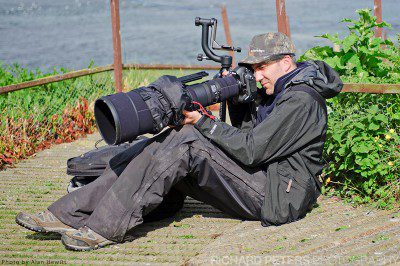
I got quite dirty, an hour before this it rained, a lot.
But then once we had been on Staple for an hour the rain started again. Surprisingly, many photographers chose to pack up their gear and just observe the rain coming down on the islands inhabitants, but not Austin, Alan and myself! We were well prepared with our waterproofs and so set about photographing some nice rainy images. It was a double edged sword, because it was great to have the rain but the puffins did very little other than stand around, and because this was the day I had the 600 VR, I was forced in to waiting for them to be in perfect range.
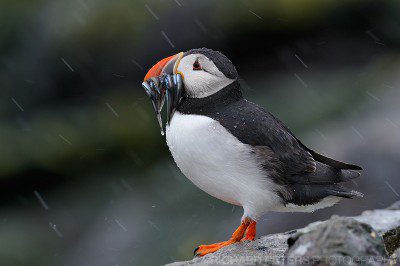
D3s, 600 VR, 1/320, f7.1, ISO 720
The up side of them not moving around much, was given how quickly our viewfinders would steam up and get covered in water, it made things a little easier, as framing anything and getting accurate focus became a big challenge. With them being stationary, it also allowed me to play around with different shutter speeds to get varying effects on the rain, capturing it as small blobs, short streaks and long streaks.
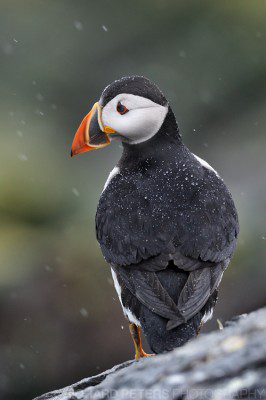
Puffin in the rain, D3s, 1/800, ISO 3600
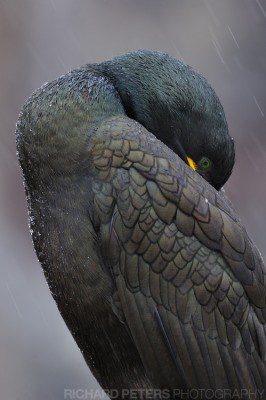
Sheltering Shag, D3s, 1/160, f8, ISO 2000
You need to be careful if it rains because the floor can get very slippery, especially if you are on the rocks as they are quite smooth, so exceptionally slippery once the rain starts to come down. I wasn’t near any puffins when the rain started, which meant I had to slowly make my way back across without slipping. If you’ve never walked on smooth wet rocks in the pouring rain before, with £12k+ of camera gear over your shoulder, let me tell you, it’s very slow going and slightly unnerving!
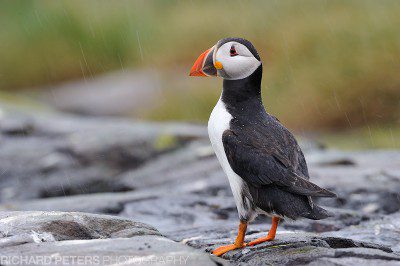
D3s, 600 VR, 1/160, f8, ISO 450
The photos may not show it, but the rain was coming down pretty hard at one point, but regardless of how wet we all got, it was worth it for the chance to get some variety in our images. But the weather wasn’t welcome by all. This poor Shag chick below looked exceptionally cold and was shivering quite a bit.
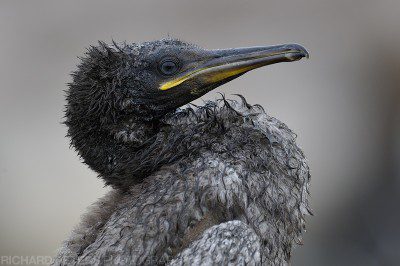
Drenched Shag chick. D3s, 600 VR, 1/160, f7.1, ISO 450
Thankfully the rain cleared by the time we were picked up from Staple. I say thankfully because if it’s raining too much, Inner Farne is closed. The reason being, the adult terns spend so much time flying up off the nests to attack people as they walk past that the eggs and young can become too wet, cold and ultimately die. But hopefully I’ve given you the idea that you really need to be prepared for all weather eventualities, especially if you are travelling from afar and will be there for a couple of days. So to sum up, wear layers of clothing, so you can strip off if it’s hot, but with an outer layer of waterproofs – and that includes for the camera (my 600 was wrapped in a ThinkTank Photo Hydrophobia 300-600). It also requires good walking boots because between the two islands you’ll walk on everything from rock (slippery when wet), to wooden boardwalks to concrete paths.
WHAT EQUIPMENT TO TAKE
The beauty of the Farne Islands is no matter what camera gear or lenses you have, you are guaranteed good shots. My personal feeling is that whatever lens you take with you will be the perfect lens. You can get close enough to most of the birds that at times a wide angle would be ideal but that being said, I opted to take my 70-200, 200-400 and 600 VR along with the D3s and D7000. Day one I took the 70-200 and 200-400 and on day two I opted to take the 600mm. A short lens will allow you to get landscape and habitat shots and the odd full frame shot where as a longer lens will let you pick off distant birds and puffins to separate them more from the surroundings, or allow you to get close up detailed portraits.
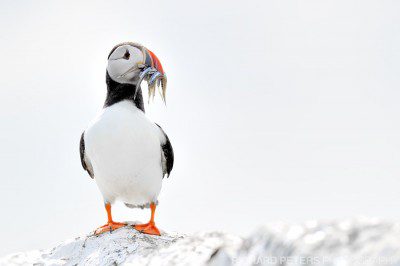
Puffin on white: D3s, 600 VR, 1/640, f5.6, ISO 200
Flight shots I found worked best with mid to long range focal lengths. But with so many targets to pick from, you should have relative success with almost any lens at your disposal!
ALL CONSUMING FLIGHT SHOTS
The Farne Islands are an amazing place and I can’t believe I’ve not been sooner, and, if they weren’t so far away I’d try and get there a couple of times each season. I thoroughly enjoyed my two days there, and the company they were kept in, with Austin and Alan being great fun with lots of banter and amusing(?) jokes keeping our spirits up even when we were cold and wet and wondering why we put ourselves through all this.
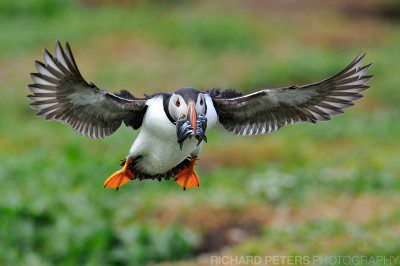
D3s, 600 VR, 1/3200, f7.1, ISO 2800
I have to admit though, after reviewing my images when I got back to London, I think I may have spent a little too much time concentrating on puffins in flight, with roughly half my time on the islands dedicated to it! But it becomes a little like an addiction. They are so small, fast (up to 40mph with 300-400 wing beats per minute!) and with so many in the sky at once (remember that video at the start of the article!) that the challenge to capture them flying on camera becomes so great that I feel like I didn’t allow myself enough time to capture enough images of the other species on the islands, or enough variations. But I wasn’t alone. On Staple especially, I was just one in a line up of thirty+ photographers trying to get these little birds on camera as they fly past on their way to their burrows with beaks full of sand eels. Every time one would come in close, the sound of 30+ cameras firing at anywhere between 5 and 9 frames per second was quite a thing to hear, although does leave you wondering slightly not only how many of those images will actually be any good, but how it’s possible to get something just that little bit different to the guys standing either side of you! The thought did cross my mind at the time, but of course, I kept on shooting, and shooting, and shooting!
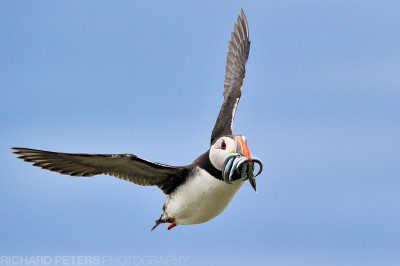
D3s, 200-400 VR, 340mm, 1/3200, f7.1, ISO 1100
So with hindsight, I’d maybe leave the flight shots next time, or just do them for a morning and that’s it. I feel with so much time spent with that I did very little other than get the typical classic puffin images you normally see. But that’s the great thing about the Farnes, there are so many opportunities that you can’t do it all in a day or two anyway, and it’s a place you can visit many times over and each time, try a different approach, which I’ll certainly do the next time I visit. If you love wildlife, you’ll love it. If you love photography, you’ll love it. And if you love wildlife photography, well…you get the idea. As you can probably tell, I’m hooked!
THANKS AND INFO
Before I wrap this up I’ve got to give a huge thanks to Andrew and Joan Douglas who run the Serenity Boat tours and the Olde School House B&B we stayed at for the duration. Both of them were extremely welcoming, helpful, informative and did everything they could to help us get the most out of the limited time we had.
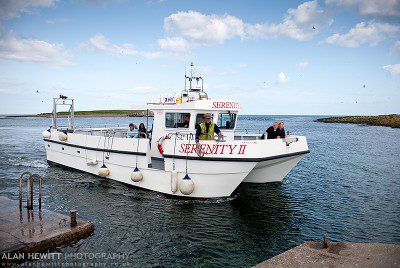
Serenity II. Image courtesy of Alan Hewitt
The B&B was very comfortable, clean and nicely decorated. Andrew was exceptionally helpful in making sure we had the maximum time we could on the islands, as well as knowing an awful lot about the wildlife there, and navigating the boat in to some great spots to let us see the birds from the water. And, after getting soaked on our second day, phoned home to Joan to arrange for Austin and I to shower and change before setting off for our 4 hours drive towards home. Truly lovely people who I highly recommend and I’ll use again without hesitation the next time I head to the Farnes! For more info, check them out here:
The Olde School House B&B
Serenity, Farne Island Boat Tours
They were great company and supplied lots of banter. No doubt I’ll be off on another adventure with them again sometime.
As an aside, Austin and I went to Bempton Cliffs the following day on our way back down the country towards home. You can read all about our efforts to photograph the nest building gannets, here.
MY FAVOURITE IMAGE FROM THE TRIP
And my favourite image from the trip? I wanted a real close up portrait of a puffin with a beak full of sand eels. And this came with the very last puffin I encountered as we left Inner Farne for the final time. I was delighted as the crowds were gone, and as this puffin walked by pretty close it turned to look at me briefly, enabling me to get the shot I had wanted all trip! As soon as I took it, I had to pack up and head back to the jetty. It was that close to the wire, but worth the wait! I wanted a really tight head shot and using the D7000 along with the 600 VR and a 1.4x TC to let me get really close and capture some lovely detail in both the puffin and the sand eels. The more I use the D7000 the more I grow to love it as a backup to my D3s! (thanks again to the guys at the official Nikon blog for the loaner)
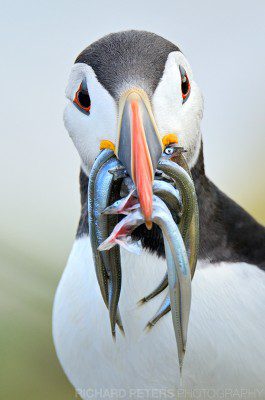
D7000, 600 VR + 1.4x TC
I can’t recommend the Farne Islands enough. Sure there is a small element of risk involved because if the weather is bad, you can’t even get on them, making it a pain if you’ve travelled from afar. But chances are you will get on the islands, and what awaits you really does have to be experienced first hand to do it full justice.
ProjectPuffin 2012? I’m up for it, are you…?








